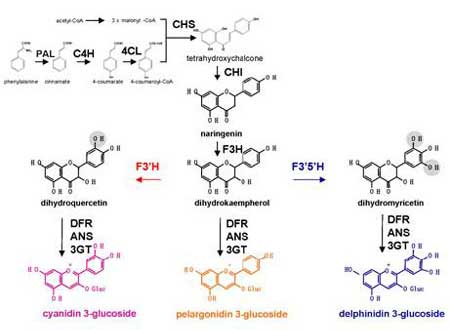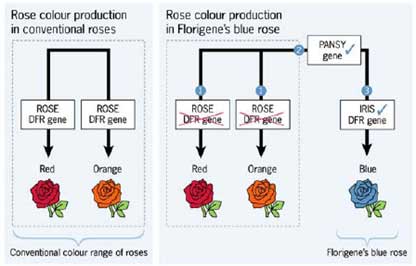The World Rose Conference 2006 was held in Osaka from May 11 to 17, 2006. During the conference, the organizers showcased an exhibition of many beautiful and impressive new rose varieties. However, the standout feature of this conference was the blue rose created using RNA interference technology, developed through the collaboration between scientists from Florigene and Suntory, with technical assistance from the Australian Scientific and Industrial Research Organization (CSIRO). The blue rose is considered the Holy Grail for rose breeders since 1840, when the gardening societies of England and Belgium offered a prize of 500,000 francs to the first person who could create a blue rose.
 The molecular geneticists from Florigene and Suntory achieved this milestone, a feat that had discouraged many traditional rose breeders, by combining a bit of old elements, a bit of new elements, some borrowed elements, and finally, a bit of the element that produces blue color. The blue color in the rose is generated by the delphinidin gene, which the Florigene scientists cloned from the pansy (Viola x wittrockiana) to synthesize the blue directly in the rose. The borrowed element is the iris gene, which produces the enzyme dihydroflavonol reductase (DFR); this enzyme completes the synthesis pathway of delphinidin in the rose. The new element is an artificial gene created by the Suntory geneticists using a novel technique called RNA interference, abbreviated as RNAi. This technique, advised by CSIRO, aims to silence the activity of the gene responsible for red coloration in roses. This gene had thwarted Florigene’s efforts to activate the delphinidin pathway in roses for nearly a decade. Consequently, Suntory’s scientists developed a “silent” gene to overcome this challenge using RNAi. RNAi is a relatively new approach in biomedical research that has emerged over the past 25 years.
The molecular geneticists from Florigene and Suntory achieved this milestone, a feat that had discouraged many traditional rose breeders, by combining a bit of old elements, a bit of new elements, some borrowed elements, and finally, a bit of the element that produces blue color. The blue color in the rose is generated by the delphinidin gene, which the Florigene scientists cloned from the pansy (Viola x wittrockiana) to synthesize the blue directly in the rose. The borrowed element is the iris gene, which produces the enzyme dihydroflavonol reductase (DFR); this enzyme completes the synthesis pathway of delphinidin in the rose. The new element is an artificial gene created by the Suntory geneticists using a novel technique called RNA interference, abbreviated as RNAi. This technique, advised by CSIRO, aims to silence the activity of the gene responsible for red coloration in roses. This gene had thwarted Florigene’s efforts to activate the delphinidin pathway in roses for nearly a decade. Consequently, Suntory’s scientists developed a “silent” gene to overcome this challenge using RNAi. RNAi is a relatively new approach in biomedical research that has emerged over the past 25 years.
The research team led by Dr. Peter Waterhouse at CSIRO in Canberra, Australia, pioneered the use of RNAi for discovering and applying gene functions in crops. Although initially the phenotype of the rose exhibited a pale mauve color, it became the first rose in the world with the genetic ability to produce true blue roses, bridging the color spectrum from a pale blue to a Mediterranean blue or even a deep blue. Thus, it can be said that this is the first commercially viable flower in the world developed through RNAi technology. The blue rose from Florigene heralds a bright future for plant breeders in the 21st century.
How is the blue rose created?
In crops, there is a type of molecule called anthocyanin, which is regarded as the principal pigment in flowers, fruits, and other cellular tissues. Typically, the main colors of flowers derive from anthocyanins, with a small presence of yellow carotenoid compounds. Furthermore, dihydrokaempferol (DHK) is an enzyme that governs the three pigment formation pathways in crops, including: cyanidin, pelargonidin, and delphinidin. The cyanidin gene encodes an enzyme that alters the DHK enzyme to form the cyanidin pathway, leading to the expression of red, pink, or mauve colors. Meanwhile, the delphinidin gene, which is absent in roses, encodes a similar enzyme to alter the DHK enzyme to synthesize color through the delphinidin pathway. Another enzyme, called dihydroflavonol reductase (DFR), supports the color formation in all three pathways (see Figure 1). This enzyme is crucial because, without it, color cannot be produced in flower petals. Therefore, mutations in the DFR gene result in white flowers. In roses, the delphinidin gene is absent, preventing color formation through its pathway. The delphinidin pathway can produce red or blue flowers under the influence of DFR and pH.
 |
|
The diagram of the anthocyanin biosynthesis pathway illustrates the role of dihydrokaempferol and the three branches leading to different colors. The red-highlighted branch is the delphinidin pathway contributing to the blue color in roses. (Photo: Florigene) |
Throughout the 20th century, rose breeders created a variety of unusual flower colors such as lilac roses or gray roses, which were seen as stepping stones towards creating blue roses. However, these were rare variants from the cyanidin pathway. Thus, we can understand why traditional breeding could not yield the desired blue roses, as roses genetically lack the genes to produce the delphinidin pathway. Therefore, the scientists at Florigene took a significant leap by cloning the delphinidin gene from wild pansies in 1991. By the mid-1990s, scientists had perfected techniques for breeding roses and producing flowers from cultured cell lines. During this period, Florigene developed the first dark red rose made from the delphinidin gene, named “Cardinal.” The combination of the cyanidin gene and the delphinidin gene resulted in a striking deep red rose variety. While it was not blue, it represented a substantial technical advancement.
To create a blue rose, the Florigene researchers needed a white rose in which the DFR gene had been inactivated. The Florigene researchers frequently consulted with Dr. Peter Waterhouse’s team at CSIRO, Australia. In 2001, Dr. Waterhouse discussed using RNAi to inhibit a desired gene, which could then be replaced with another gene. Thus, Florigene’s scientists  immediately recognized the benefits of using RNAi to suppress the activity of the DFR gene in red roses, thus inhibiting the cyanidin pathway and subsequently replacing it with a new DFR gene to complete the delphinidin synthesis pathway in roses. Simultaneously, researchers from Suntory, Japan, had the same idea, using RNAi to inhibit the DFR gene and then cloning a new delphinidin gene from pansies and a DFR gene from iris. The DFR genes in roses and iris are quite similar and share many DNA sequences, but RNAi is also very sophisticated because it can suppress the DFR gene in roses without affecting the DFR gene in iris by creating an inhibitory gene structure that generates hairpin dsRNA molecules with sequences complementary to the DFR gene in roses.
immediately recognized the benefits of using RNAi to suppress the activity of the DFR gene in red roses, thus inhibiting the cyanidin pathway and subsequently replacing it with a new DFR gene to complete the delphinidin synthesis pathway in roses. Simultaneously, researchers from Suntory, Japan, had the same idea, using RNAi to inhibit the DFR gene and then cloning a new delphinidin gene from pansies and a DFR gene from iris. The DFR genes in roses and iris are quite similar and share many DNA sequences, but RNAi is also very sophisticated because it can suppress the DFR gene in roses without affecting the DFR gene in iris by creating an inhibitory gene structure that generates hairpin dsRNA molecules with sequences complementary to the DFR gene in roses.
Therefore, to create the blue rose, the Suntory scientists applied a trio of genes. An artificial gene was used for the RNAi technique to inhibit the DFR gene in roses, preventing the expression of color. They then introduced the delphinidin gene from pansies and the DFR gene from iris to create roses with a high content of delphinidin in the petals (see Figure 2). However, it is essential to note a factor that influences the blue color in the petals, which is the cellular pH. This is one of the main reasons why flowers with the same anthocyanin pathway can exhibit different colors. When the cellular pH is alkaline, the anthocyanin pigments tend to appear bluer. The soil pH does not significantly affect the cellular pH of the flower petals. The cellular pH of rose petals is typically around 4.5; thus, creating rose petals with lower pH levels is quite limited. As a result, scientists considered using RNAi to inhibit genes affecting the acidity of the petals or to adjust the color of the petals in different directions.

The process of forming the blue rose with the support of RNAi technology.
(Photo: CSIRO)
The blue rose is one of the products created through the application of RNAi technology. It is one of many applications of RNAi in biomedical research and a very useful tool for understanding and exploring the mysterious functions of genes in the post-genomic era.

















































